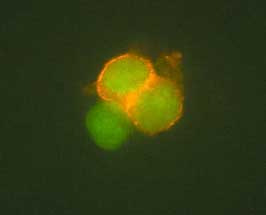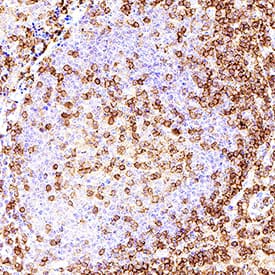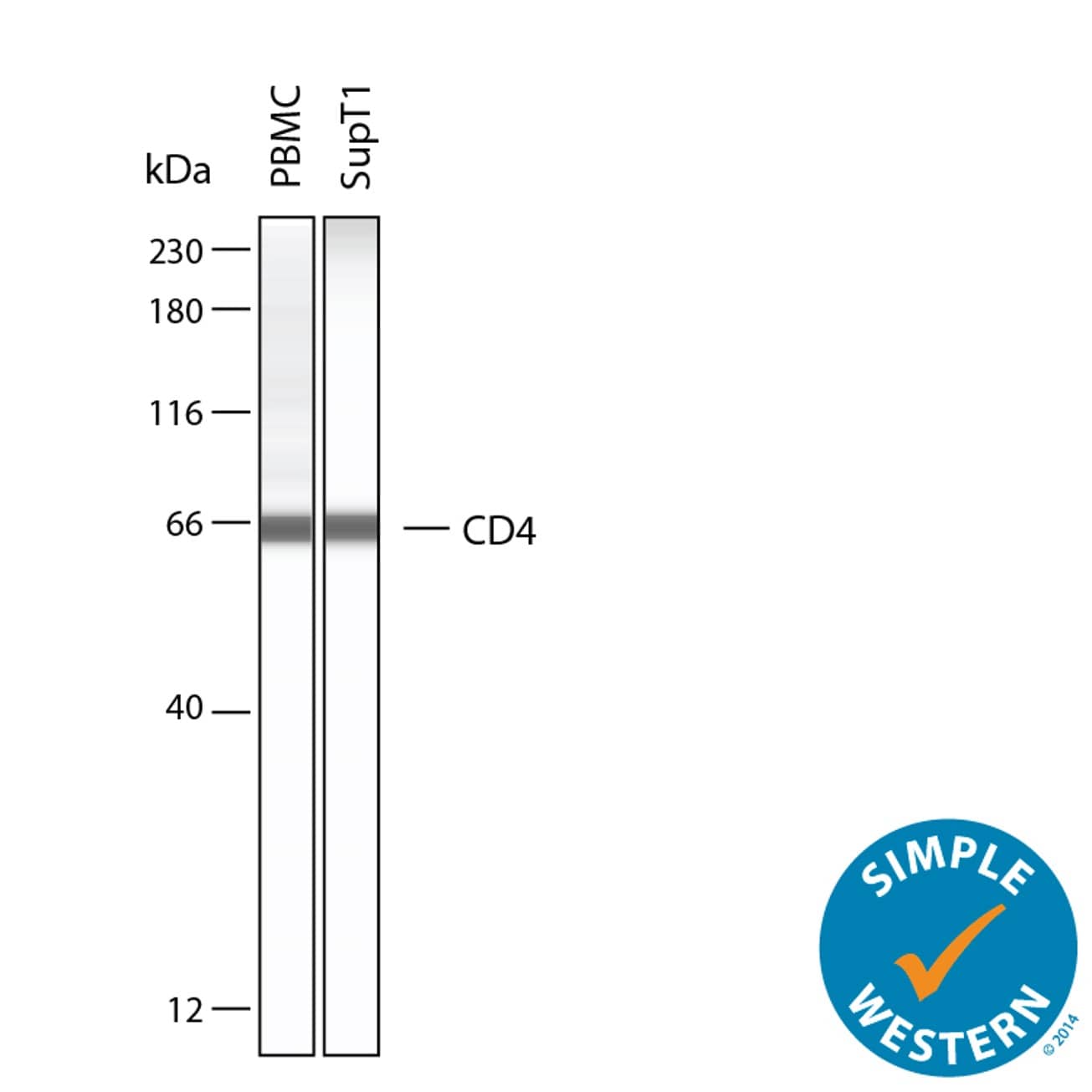Human CD4 Antibody Summary
Lys26-Trp390
Accession # P01730
Applications
Please Note: Optimal dilutions should be determined by each laboratory for each application. General Protocols are available in the Technical Information section on our website.
Scientific Data
 View Larger
View Larger
CD4 in Human T Cells. CD4 was detected in immersion fixed human T cells using 2 µg/mL Goat Anti-Human CD4 Antigen Affinity-purified Polyclonal Antibody (Catalog # AF‑379‑NA) for 3 hours at room temperature. Cells were stained (red) and counterstained (green). View our protocol for Fluorescent ICC Staining of Cells on Coverslips.
 View Larger
View Larger
CD4 in Human PBMCs. CD4 was detected in immersion fixed human peripheral blood mononuclear cells (PBMCs) using Goat Anti-Human CD4 Antigen Affinity-purified Polyclonal Antibody (Catalog # AF-379-NA) at 10 µg/mL for 3 hours at room temperature. Cells were stained using the NorthernLights™ 557-conjugated Anti-Goat IgG Secondary Antibody (yellow; NL001) and counterstained with DAPI (blue). View our protocol for Fluorescent ICC Staining of Non-adherent Cells.
 View Larger
View Larger
CD4 in Human Tonsil Tissue. CD4 was detected in immersion fixed paraffin-embedded sections of human tonsil tissue using Goat Anti-Human CD4 Antigen Affinity-purified Polyclonal Antibody (Catalog # AF-379-NA) at 1.7 µg/mL for 1 hour at room temperature followed by incubation with the Anti-Goat IgG VisUCyte™ HRP Polymer Antibody (VC004). Before incubation with the primary antibody, tissue was subjected to heat-induced epitope retrieval using Antigen Retrieval Reagent-Basic (CTS013). Tissue was stained using DAB (brown) and counterstained with hematoxylin (blue). Specific staining was localized to cell surface of lymphocytes. Staining was performed using our IHC Staining with VisUCyte HRP Polymer Detection Reagents protocol.
 View Larger
View Larger
Detection of Human CD4 by Western Blot. Western blot shows lysates of PBMC and SUP‑T1 human T cell lymphoblastic lymphoma cells. PVDF membrane was probed with 1 µg/mL of Goat Anti-Human CD4 Antigen Affinity-purified Polyclonal Antibody (Catalog # AF-379-NA) followed by HRP-conjugated Anti-Goat IgG Secondary Antibody (Catalog # HAF017). A specific band was detected for CD4 at approximately ~55kDa kDa (as indicated). This experiment was conducted under reducing conditions and using Western Blot Buffer Group 1.
 View Larger
View Larger
Detection of Human CD4 by Simple WesternTM. Simple Western lane view shows lysates of Human PBMC and SUP‑T1 human T cell lymphoblastic lymphoma cell line, loaded at 0.2 mg/mL. A specific band was detected for CD4 at approximately 65 kDa (as indicated) using 10 µg/mL of Goat Anti-Human CD4 Antigen Affinity-purified Polyclonal Antibody (Catalog # AF-379-NA). This experiment was conducted under reducing conditions and using the 12-230 kDa separation system.
Preparation and Storage
- 12 months from date of receipt, -20 to -70 °C as supplied.
- 1 month, 2 to 8 °C under sterile conditions after reconstitution.
- 6 months, -20 to -70 °C under sterile conditions after reconstitution.
Background: CD4
CD4 is an approximately 55 kDa type I membrane glycoprotein that is expressed predominantly on most thymocytes and a subset of mature T lymphocytes. In humans, CD4 is also expressed to a lesser extent on monocytes and macrophage related cells. Human CD4 cDNA encodes a 458 amino acid (aa) residue precursor protein with a 25 aa residue signal peptide, a 371 aa residue extracellular region containing four immunoglobulin homology domains, a 24 aa residue transmembrane domain and a 38 aa residue cytoplasmic domain. CD4 is a coreceptor required for T cell recognition of antigens that are presented by class II major histocompatibility complexes. CD4 has been shown to be a coreceptor of HIV entry and specifically binds gp120, the external envelope glycoprotein of HIV.
Product Datasheets
Citations for Human CD4 Antibody
R&D Systems personnel manually curate a database that contains references using R&D Systems products. The data collected includes not only links to publications in PubMed, but also provides information about sample types, species, and experimental conditions.
30
Citations: Showing 1 - 10
Filter your results:
Filter by:
-
Human Inner Ear Immune Activity: A Super-Resolution Immunohistochemistry Study
Authors: Liu W, Kampfe Nordstrom C, Danckwardt-Lilliestrom N, Rask-Andersen H,
Front Neurol
-
Stem-like T cells are associated with the pathogenesis of ulcerative colitis in humans
Authors: Li, Y;Ramírez-Suástegui, C;Harris, R;Castañeda-Castro, FE;Ascui, G;Pérez-Jeldres, T;Diaz, A;Morong, C;Giles, DA;Chai, J;Seumois, G;Sanchez-Elsner, T;Cummings, F;Kronenberg, M;Vijayanand, P;
Nature immunology
Species: Human
Sample Types: Whole Tissue
Applications: Immunohistochemistry -
Smith-specific regulatory T cells halt the progression of lupus nephritis
Authors: Eggenhuizen, PJ;Cheong, RMY;Lo, C;Chang, J;Ng, BH;Ting, YT;Monk, JA;Loh, KL;Broury, A;Tay, ESV;Shen, C;Zhong, Y;Lim, S;Chung, JX;Kandane-Rathnayake, R;Koelmeyer, R;Hoi, A;Chaudhry, A;Manzanillo, P;Snelgrove, SL;Morand, EF;Ooi, JD;
Nature communications
Species: Xenograft
Sample Types: Whole Tissue
Applications: Immunohistochemistry -
Tertiary lymphoid structures correlate with enhancement of antitumor immunity in esophageal squamous cell carcinoma
Authors: Nakamura, S;Ohuchida, K;Hayashi, M;Katayama, N;Tsutsumi, C;Yamada, Y;Hisano, K;Okuda, S;Ohtsubo, Y;Iwamoto, C;Torata, N;Mizuuchi, Y;Shindo, K;Nakata, K;Moriyama, T;Morisaki, T;Oda, Y;Nakamura, M;
British journal of cancer
Species: Human
Sample Types: Whole Tissue
Applications: IHC -
An agonistic anti-signal regulatory protein alpha antibody for chronic inflammatory diseases
Authors: Markus M. Xie, Bingbing Dai, Jason A. Hackney, Tianhe Sun, Juan Zhang, Janet K. Jackman et al.
Cell Reports Medicine
-
Establishment of a humanized mouse model of keloid diseases following the migration of patient immune cells to the lesion: Patient-derived keloid xenograft (PDKX) model
Authors: Lee, AR;Lee, SY;Choi, JW;Um, IG;Na, HS;Lee, JH;Cho, ML;
Experimental & molecular medicine
-
Step-dose IL-7 treatment promotes systemic expansion of T cells and alters immune cell landscape in blood and lymph nodes
Authors: Hrishikesh Pandit, Antonio Valentin, Matthew Angel, Claire Deleage, Cristina Bergamaschi, Jenifer Bear et al.
iScience
-
Tumor Lymphocyte Infiltration Is Correlated with a Favorable Tumor Regression Grade after Neoadjuvant Treatment for Esophageal Adenocarcinoma
Authors: R Haddad, O Zlotnik, T Goshen-Lag, M Levi, E Brook, B Brenner, Y Kundel, I Ben-Aharon, H Kashtan
Journal of personalized medicine, 2022-04-13;12(4):.
Species: Human
Sample Types: Whole Tissue
Applications: IHC -
Microbial Protein Binding to gC1qR Drives PLA2G1B-Induced CD4 T-Cell Anergy
Authors: Julien Pothlichet, Annalisa Meola, Florence Bugault, Louise Jeammet, Anne G. Savitt, Berhane Ghebrehiwet et al.
Frontiers in Immunology
-
E4orf1 Suppresses E1B-Deleted Adenovirus Vaccine-Induced Immune Responses
Authors: K Sangare, S Helmold Ha, M Moore, C Hogge, T Hoang, MA Rahman, DJ Venzon, C LaBranche, D Montefiori, M Robert-Gur, MA Thomas
Vaccines, 2022-02-15;10(2):.
Species: Human
Sample Types: Cell Lysates, Whole Cells
Applications: Flow Cyomtetry, Western Blot -
Distribution of Immune Cells Including Macrophages in the Human Cochlea
Authors: Liu W, Danckwardt-Lilliestr�m N, Schrott-Fischer A et al.
Frontiers in Neurology
-
Pilot Study of Anti-Th2 Immunotherapy for the Treatment of Breast Cancer-Related Upper Extremity Lymphedema
Authors: BJ Mehrara, HJ Park, RP Kataru, J Bromberg, M Coriddi, JE Baik, J Shin, C Li, MR Cavalli, EM Encarnacio, M Lee, KJ Van Zee, E Riedel, JH Dayan
Biology, 2021-09-18;10(9):.
Species: Human
Sample Types: Whole Tissue
Applications: IHC -
Increased Circulating T Follicular Helper Cells Induced via IL-12/21 in Patients With Acute on Chronic Hepatitis B Liver Failure
Authors: Bingying Du, Jiaming Teng, Rongkun Yin, Yuanyuan Tian, Tingwang Jiang, Yanan Du et al.
Frontiers in Immunology
-
PLA2G1B is involved in CD4 anergy and CD4 lymphopenia in HIV-infected patients
Authors: Julien Pothlichet, Thierry Rose, Florence Bugault, Louise Jeammet, Annalisa Meola, Ahmed Haouz et al.
Journal of Clinical Investigation
-
Lymphoid Aggregates in the CNS of Progressive Multiple Sclerosis Patients Lack Regulatory T Cells
Authors: Luisa Bell, Alexander Lenhart, Andreas Rosenwald, Camelia M. Monoranu, Friederike Berberich-Siebelt
Frontiers in Immunology
-
Persistence of a T Cell Infiltrate in Human Ganglia Years After Herpes Zoster and During Post-herpetic Neuralgia
Authors: JP Sutherland, M Steain, ME Buckland, M Rodriguez, AL Cunningham, B Slobedman, A Abendroth
Front Microbiol, 2019-09-11;10(0):2117.
Species: Human
Sample Types: Whole Tissue
Applications: IHC-P -
Cellular and inter-cellular rewiring of the human colon during ulcerative colitis
Authors: Christopher S. Smillie, Moshe Biton, Jose Ordovas-Montanes, Keri M. Sullivan, Grace Burgin, Daniel B. Graham et al.
Cell
-
Distinct Inflammatory Profiles in Atopic and Nonatopic Patients With Chronic Rhinosinustis Accompanied by Nasal Polyps in Western China
Authors: Luo Ba, Jintao Du, Feng Liu, Fenglin Yang, Miaomiao Han, Sixi Liu et al.
Allergy, Asthma & Immunology Research
-
Tumor-specific cytotoxic T lymphocyte activity determines colorectal cancer patient prognosis.
Authors: Reissfelder C, Stamova S, Gossmann C, Braun M, Bonertz A, Walliczek U, Grimm M, Rahbari N, Koch M, Saadati M, Benner A, Buchler M, Jager D, Halama N, Khazaie K, Weitz J, Beckhove P
J Clin Invest, 2014-12-22;125(2):739-51.
Species: Human
Sample Types: Whole Tissue
Applications: IHC-Fr -
HIV-1 gp120 activates the STAT3/interleukin-6 axis in primary human monocyte-derived dendritic cells.
Authors: Del Corno M, Donninelli G, Varano B, Da Sacco L, Masotti A, Gessani S
J Virol, 2014-07-09;88(19):11045-55.
Species: Human
Sample Types: Whole Cells
Applications: Neutralization -
Slow turnover of HIV-1 receptors on quiescent CD4+ T cells causes prolonged surface retention of gp120 immune complexes in vivo.
Authors: Suzuki, Yasuhiro, Gatanaga, Hiroyuki, Tachikawa, Natsuo, Oka, Shinichi
PLoS ONE, 2014-02-06;9(2):e86479.
Species: Human
Sample Types: Whole Cells
Applications: ICC -
A role for microRNA-155 modulation in the anti-HIV-1 effects of Toll-like receptor 3 stimulation in macrophages.
Authors: Swaminathan G, Rossi F, Sierra L, Gupta A, Navas-Martin S, Martin-Garcia J
PLoS Pathog, 2012-09-20;8(9):e1002937.
Species: Human
Sample Types: Whole Cells
Applications: ICC -
Patients with cystic fibrosis have inducible IL-17+IL-22+ memory cells in lung draining lymph nodes.
Authors: Chan Y, Chen K, Duncan S, Lathrop K, Latoche J, Logar A, Pociask D, Wahlberg B, Ray P, Ray A, Pilewski J, Kolls J
J Allergy Clin Immunol, 2012-07-11;131(4):1117-29, 1129.
Species: Human
Sample Types: Whole Tissue
Applications: IHC -
Lymphoid Tissue Damage in HIV-1 Infection Depletes Naïve T Cells and Limits T Cell Reconstitution after Antiretroviral Therapy
Authors: Ming Zeng, Peter J. Southern, Cavan S. Reilly, Greg J. Beilman, Jeffrey G. Chipman, Timothy W. Schacker et al.
PLoS Pathogens
Species: Human
Sample Types: Whole Tissue
Applications: Immunohistochemistry -
T cell infiltrates in the muscles of patients with dermatomyositis and polymyositis are dominated by CD28null T cells.
Authors: Fasth AE, Dastmalchi M, Rahbar A, Salomonsson S, Pandya JM, Lindroos E, Nennesmo I, Malmberg KJ, Soderberg-Naucler C, Trollmo C, Lundberg IE, Malmstrom V
J. Immunol., 2009-09-14;183(7):4792-9.
Species: Human
Sample Types: Whole Tissue
Applications: IHC -
Restricted T cell receptor BV gene usage in the lungs and muscles of patients with idiopathic inflammatory myopathies.
Authors: Englund P, Wahlstrom J, Fathi M, Rasmussen E, Grunewald J, Tornling G, Lundberg IE
Arthritis Rheum., 2007-01-01;56(1):372-83.
Species: Human
Sample Types: Whole Tissue
Applications: IHC -
An effective cancer vaccine modality: lentiviral modification of dendritic cells expressing multiple cancer-specific antigens.
Authors: Wang B, He J, Liu C, Chang LJ
Vaccine, 2006-02-28;24(17):3477-89.
Species: Human, Primate
Sample Types: Whole Cells
Applications: ICC -
Roles for herpes simplex virus type 1 UL34 and US3 proteins in disrupting the nuclear lamina during herpes simplex virus type 1 egress.
Authors: Bjerke SL, Roller RJ
Virology, 2006-01-19;347(2):261-76.
Species: Human, Primate - Cholrocebus pygerythrus (Vervet Monkey)
Sample Types: Whole Cells
Applications: ICC -
A Map of Human Type 1 Diabetes Progression by Imaging Mass Cytometry
Authors: Damond N, Engler S, Zanotelli VRT et al.
Cell Metab.
-
Integrative proteo-transcriptomic and immunophenotyping signatures of HIV-1 elite control phenotype: A cross-talk between glycolysis and HIF signaling
Authors: AkusjArvi SS, Ambikan AT, Krishnan S Et al.
iScience
FAQs
No product specific FAQs exist for this product, however you may
View all Antibody FAQsReviews for Human CD4 Antibody
Average Rating: 3.5 (Based on 2 Reviews)
Have you used Human CD4 Antibody?
Submit a review and receive an Amazon gift card.
$25/€18/£15/$25CAN/¥75 Yuan/¥2500 Yen for a review with an image
$10/€7/£6/$10 CAD/¥70 Yuan/¥1110 Yen for a review without an image
Filter by:








